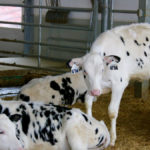Tag Archives Colostrum

Colostrum has value for sick calves
Colostrum testing and feeding frequency has risen on Canadian dairy farms

Quality colostrum vital for small ruminant newborns
Dam nutrition is key to increasing quality, quantity and in utero trace minerals

Boosting IgG levels in calves’ early meals
Speakers see potential benefits from changes in colostrum management

Transition milk continues to show benefits
Improved gut health and reduced mortality are some benefits

Understanding the ‘what’ and ‘how’ of colostrum for calves
Some fundamentals about what we should be feeding and how we can assist calves

Are dry cow diets decreasing colostrum quantity?
Specialists ponder trend of low yield from first and second milkings

Group housing gives insight into tailored calf diets
Partnered calves had greater dry matter consumption than singles

Success with beef starts at the calf level
A veterinarian says farmers cut back on animal health as a cost saving

Calves benefit from longer colostrum feeding
Gut development is enhanced if they get more than a couple of colostrum feedings

Calves benefit from mother’s post-colostrum milk
University of Guelph study identifies ‘bio-actives’ in days two to four of lactation


